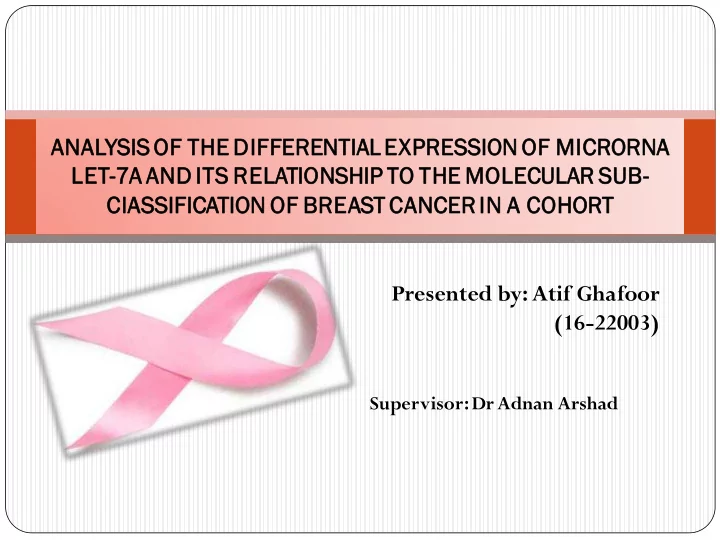

ANALYSIS IS OF THE DIFFERENT NTIA IAL EXPRESSIO ION N OF MICRORNA NA LET-7A AND ITS RELATIO IONS NSHIP IP TO THE MOLECULAR SUB- ClASSIF IFIC ICATIO ION OF BREAST CANC NCER IN A C COHORT Presented by: Atif Ghafoor (16-22003) Supervisor: Dr Adnan Arshad
Breast Cancer Heterogeneous group of disease which is govern by followings hallmarks
Incidence and mortality of Breast cancer According to Punjab Cancer Registry report of 2014, 1393 (44.3%) women were diagnosed with breast cancer in Punjab area
Histological Diagnosis
Molecular Diagnosis luminal A, (ER + & low grade) luminal B, (ER + but high grade) tumor enriched with human epidermal growth factor receptor 2 (Her2), basal-like (ER-, PR-, HER2/ Nue -)
Research Query Breast Cancer had been studied extensively at the molecular level but most of the molecular mechanisms underlying its progression and metastasis remain poorly understood This has led to a significant interest in the quest for novel predictive markers for breast cancer Intensifying research in miRNA studies has resulted in the identification and confirmation of aberrant miRNA expression in a number of human diseases including Breast Cancer
Micro RNA miRNAs are endogenous, noncoding small RNAs with 20 – 25 nucleotides in length They play an important regulatory role through complimentary binding of the 3 ′ untranslated regions (UTRs) of target genes thus resulting in the degradation of the target mRNA and inhibition of translation The oncogenic miRNAs (oncomiRs) display anti-apoptotic activity and are over expressed in cancer cells In contrast, miRNAs with anti-proliferative and proapoptotic activity function as tumor-suppressors and are under expressed in cancer cells Different types of cancers at different developmental stages display unique expression profiles of different microRNAs
Biogenesis of microRNA
miRNA in Breast Cancer Ref: Yin-Yuan et al, Jour of Cancer Biology & Therapy, 2013.14:3,201-212
Let-7 family of miRNA a, b, c, d, e, f, g, i
OBJECTIVE OF THE STUDY To evaluate the miRNA let 7a expression in breast cancer and fibroadenoma To evaluate the expression of Let-7a in Relationship To The Molecular Sub Classification Of Breast Cancer
Material & Method
Sample Collection UHS Study Design Sample Type (Retrospective) FFPE Tissue Advanced Experimental Study Board Sample Size Site Approval 50 FCCU Biological Science Labs Data Analysis Study Duration SPSS or Graphpad 6-8 months Prism 6
Inclusion Criteria: Exclusion criteria: Histologically confirmed Males diagnosed cases of breast cancer patients <30 or >65 of age Females History or presence of other cancers Ages Eligible for Study: 30 Years to 65Years
FFPE Blocks 20 μm Scetion Extraction of Total nucleic Acid Ambion (ThermoFisher Scientic) (According to manufacturer instructions) IHC Staining RNA purity was assessed using a ER-Alpha, Beta Nanodrop 2000 AR, HER2/Nue Preparation of cDNA ThermoFisherScientic Analysis of slides by pathologist qRT-PCR Taq man Advanced miRNA kit Assay I.D 478575 Analysis of product
Re Results ts
Histological appearance of Fibroadenoma Nodular and encapsulated Epithelial proliferation appears in a single terminal ductal unit
Histological appearance of IDC Desmoplastic reaction in stroma (abundant fibrosis and collagen deposition) Round to oval nuclei with few mitoses Tumor necrosis
Molecular Sub Classifi fication of Breast Cancer Molecular sub classification Percentage of patient 33% 38 % 5% 23% LuminalA Luminal B Her 2-Nue TNB
Immunohis unohistoc ochemis hemistry y (IHC) ) on tissue ue samples les
Luminal A ER- α + HER2/Nue -
Luminal B ER- α + HER2/Nue +
Her 2 enrich iched Triple Negat ativ ive 40 45 40 35 35 30 30 25 No of cases No of cases 25 20 20 15 15 10 10 5 5 0 Axis Title 0 Total Cases No of case Total Cases TNB Cases
ER- b and AR Expression Estrogen Receptor- b + Androgen Receptor +
ER- b and AR Expression 100 90 80 70 60 Percentage 50 40 30 20 10 0 Negative Positive Negative Positive ER- β AR
Expression of Let-7a
L et7a is decreased in invasive ductal carcinoma (IDC) but over expressed in Fibroadenoma 120 100 80 Fold Increase/Decrease 60 40 20 0 -20 -40 U6 Fibroadenoma LuminalA Luminal B HER2-Nue TNB -60 Molecular subtype of breast cancer
Let 7a dow own n regula ulation ion in high h grade de & stage e II and III IDC STAGE IV 0 STAGE III 14 STAGE STAGE II 7 STAGE I 0 STAGE 0 0 2+3 GRADE 21 1 0 0 5 10 15 20 25 Let 7a Down Expression
IDC and FA showed inverse expression of let-7a a with AR and ER ER-beta a recepto ptor staining Let-7a Expression in IDC Parameters No of cases Down Percentage UP Percentage 3 Positive 0 0 1 35 AR Negative 34 21 62 12 29 ER Positive 16 47 10 - β 9 Negative 34 5 15 3 Let-7a Expression in Fibroadenoma Parameters No of cases Down Percentage UP Percentage 80 Positive 1 20 4 0 AR Negative 5 0 0 0 100 ER Positive 0 0 5 - β 0 Negative 5 0 0 0
Conclus lusion ion Let 7a down regulation seen in cases of invasive ductal carcinoma We identified that let-7a down regulation directly correlates with increase grade of invasive ductal carcinoma In Benin breast cancer disorder like fibroadenoma shows increase microRNA let-7a expression. let 7a expression is a predictive of molecular subtyping in breast cancer Inverse correlation of miRNA let-7a exist in breast cancer related to ER- β and AR Altered let-7 family expression is likely to contribute to cancer formation and also progression
Future Prospects of the study Use of these unique microRNA expression patterns as tumor diagnostic and prognostic tools, but also for future microRNA gene therapy We will try to increase no of cases and controls We will diversifies group by including's of others types of breast cancer We will include other types of let-7a family member to device molecular signature
Recommend
More recommend